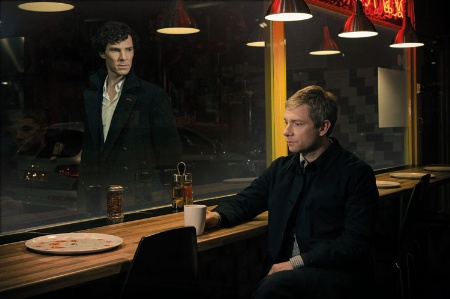Source: BBC/Hartswood Films
‘Home-grown superhero’: Sherlock Holmes represents an idealised image of Victorian manhood, an intellectual knight errant
Sherlock, Series 3
Created by Mark Gatiss and Steven Moffat
Starring Benedict Cumberbatch and Martin Freeman
BBC One, January 2014
Productions such as Sherlock and Ripper Street use academics to find out where the parameters are, and where they can break them
This week marks the return of Benedict Cumberbatch’s cheekbones to our screens, as the BBC’s modernised adaptation of the Sherlock Holmes stories begins its third run.
Our continuing obsession with the Victorians can be seen everywhere, with shows such as BBC One’s Ripper Street and the New York-set Copper playing on this long-standing love affair. Jonathan Rhys Meyers’ current incarnation as Dracula on Sky Living, and Daniel Radcliffe’s latest role as Igor in Paul McGuigan’s Frankenstein – expected in 2015 – show that the gothic monsters of Victorian literature are still capable of enthralling us; but in a world fixated on comic book superheroes and the supernatural, how does “the world’s greatest detective” stand the test of time?
Cumberbatch’s star was already rising during the last series but has now gone stratospheric. The Lazarus-like revival of his Sherlock bears the hallmarks of this newfound status, with a sensual maturity and physical presence only hinted at before. The show, too, has matured, gaining an impressively substantial fan base and its first-ever inclusion in that passionate celebration of all things superhero-related – San Diego’s Comic-Con 2013. Here, alongside the American superheroes of the Marvel and DC universes, as well as the stars, writers and producers of other cult television shows, you might be surprised to find the creators of the BBC’s new version of Sherlock Holmes – a highly intellectual and emotionally repressed man in a deerstalker hat.
“Sherlock Holmes is the closest thing we have to an authentic home-grown superhero,” says Toby Finlay, one of the writers behind two of the BBC’s most striking offerings of 2013, Peaky Blinders and Ripper Street. “The Americans have Superman, Batman, the canon of comic book folklore. Our legendary British heroes are Sherlock Holmes and, maybe, King Arthur.” (The other obvious contender being James Bond.)
Like the US comic-book heroes, Sherlock has his fair share of die-hard fans prepared to shell out on T-shirts, earrings and assorted oddities that bear his name, so the idea of Holmes as the quintessential British superhero is not so far-fetched. He has a faithful Robin in Dr Watson, a steadfastly loyal Alfred in Mrs Hudson and, instead of the gadgets and money of Bruce Wayne, he uses his towering intellect and powers of deduction to solve the crimes he investigates.
Although he has been updated by the BBC, Sherlock Holmes has been a British pin-up for well over a century. But why has his appeal lasted for so long, and what is it about this fictional man that we find so intriguing? He first appeared in 1887, the year before the Jack the Ripper murders, which held the entire country in thrall to the investigation that followed. An instant success for their author, Sir Arthur Conan Doyle, Sherlock Holmes and his adventures continued to appear until 19, in serialisations, novels and plays.

He represents an idealised image of Victorian manhood, someone bound by a code of honour; a chivalrous, loyal adventurer – the intellectual knight errant, romanticised at a time when the image of Victorian masculinity was being questioned by the nascent women’s suffrage movement. The 1885 fight to raise the age of consent for girls from 13 to 16 had highlighted the vulnerability of Victorian women, exposing certain middle- and upper-class men as the perpetrators of sexual violence and abuse against vulnerable working-class children. Elsewhere in literature, from Robert Louis Stevenson’s The Strange Case of Dr Jekyll and Mr Hyde (1886) to Bram Stoker’s Dracula (1897), the intellectual elite is portrayed as deviant and dangerous, driven by menacingly sexualised impulses.
Sherlock Holmes was the antidote to all that, a paragon of virtue with little supposed interest in the opposite sex. It’s as if Conan Doyle’s reaction to the social upheaval surrounding him was to create a contemporary image of manhood so pure, so perfect, that there was little to set Holmes apart from a knight of King Arthur’s medieval court. Conan Doyle’s gravestone bears the epitaph “Steel True. Blade Straight. Arthur Conan Doyle. Knight, Patriot, Physician & Man Of Letters”, a tellingly declarative statement favouring the historical values of a time far removed from his own. It is, perhaps, a final attempt to stamp on his memory the importance of honour and respectability.
“What appeals to me about that late Victorian setting is that it’s an era of great existential spasm – old certainties smashed to rubble, and shattering new ideas rupturing the peace,” says Finlay, of the 1890s backdrop to Ripper Street’s Whitechapel-based police investigations. That world is far removed from the high-society blackmail and royal intrigue that Sherlock Holmes is perhaps better acquainted with, but the common theme of a Victorian detective – here, Matthew Macfadyen’s inimitable Inspector Reid, supported by Jerome Flynn’s thunderous portrayal of Sergeant Bennet Drake and Adam Rothenberg’s charismatic Captain Jackson – still managed to seize the public imagination. (An extensive fan base is loudly campaigning for a third series while the show teeters on the brink of its own Reichenbach Fall.) Inspector Reid is another Victorian knight errant on a quest to secure truth and justice for those within his domain and, as with the original Holmes, his creators use his character to examine the social questions of their own time, touching on everything from sexuality to political corruption.
One of Ripper Street’s more surprising story lines came from the 1889 Cleveland Street Scandal, with its lurid details of relationships between Post Office telegram boys and members of the aristocracy. Some viewers reacted against Inspector Reid’s progressive stance towards the homosexual nature of the case, believing that such an attitude was too jarring, and too modern, for their popular perceptions of the Victorians. But one of the great achievements of Ripper Street is its visceral dedication to recreating the authentic Victorian world, using original historical material, language and ideas. It is a new breed of historical drama, drawing on the work of historians and academics to create a dramatic aesthetic that also exposes us to the historical reality – making you see attitudes in the past that you may not want to believe existed. What shocks and surprises us is not that the Victorians were so different, but actually that they were so like us.
“I think productions use academics to find out where the parameters are, and where they can break them,” says writer and broadcaster Matthew Sweet, author of Inventing the Victorians. “The historian might bring something more outlandish than [the producers] themselves might have considered…[It] is something writers are starting to wake up to, and authenticity can be surprising.”
Historical dramas face the challenge of walking the fine line between myth and reality, putting what we believe to be true up against the historical record left to us by our ancestors. That clash is due to be re-examined in John Logan’s new series for Showtime, Penny Dreadful, on our screens later this year. This turns the men and monsters of the gothic world – including Dr Frankenstein and Dorian Gray – into living subjects of the real Victorian century. Popular culture regularly tells us that monsters can be superheroes too, and yet our returning favourite, Sherlock Holmes, is, at his core, just a man.
Perhaps that is why we are happy to see Holmes as one of our superheroes, whatever century he inhabits. From his beginnings as a re-imagined Victorian knight to the muscular 21st-century misfit of “The Empty Hearse”, the first episode of the new series, the image we now have of Sherlock Holmes is one that is capable of standing alongside Batman, Superman and Spider-Man as an icon for our age. He is a welcome return to our screens and, as John Watson says in that first episode, “don’t pretend you’re not enjoying this…being back, being a hero again…being Sherlock Holmes”.
Register to continue
Why register?
- Registration is free and only takes a moment
- Once registered, you can read 3 articles a month
- Sign up for our newsletter
Subscribe
Or subscribe for unlimited access to:
- Unlimited access to news, views, insights & reviews
- Digital editions
- Digital access to THE’s university and college rankings analysis
Already registered or a current subscriber? Login

